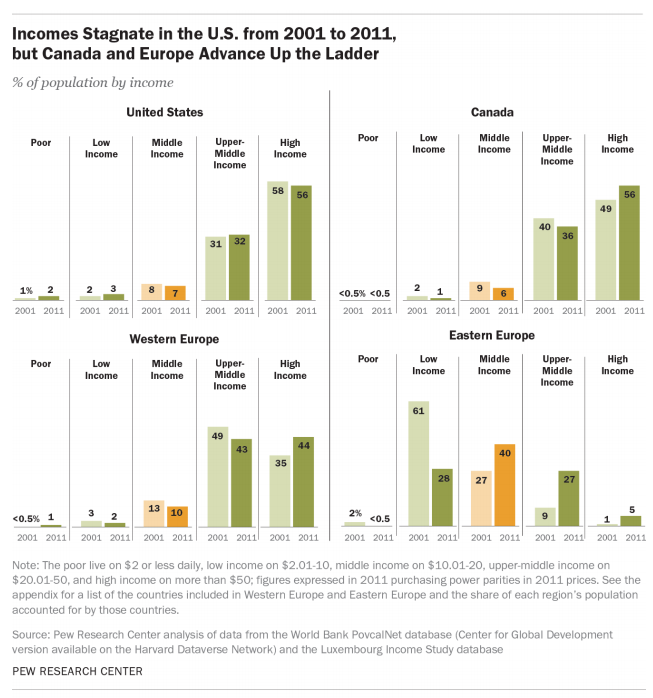No, we didn't think so. But try the wealth calculator below anyway and confirm your status. JL
Suelain Moi reports in The Fiscal Times:
If you’re reading this article in the U.S. or the U.K., you’re likely already in the top 29 percent. That’s because you’re making $50 or more a day. In a global context, the Pew study says, “a much greater share of Americans and Europeans are middle or higher income than are people in emerging and developing nations.”
This little exercise might make you feel a bit better about your standing in the world. As part of a huge study on the state of the global middle class, the Pew Research Center has created a new tool that lets you see how your income stacks up with that of households worldwide.To find out, just enter your country, the number of people in your household, and your annual, weekly, or monthly income into the calculator below. (Pew says it doesn’t store or share any of the data you enter.)
According to the Pew study, only 13 percent of the world’s population can be considered middle class. Most people in the world fall into either the low-income (56 percent) or poor (15 percent) brackets. They live on less than $10 per day, with the poorest living on less than $2 per day.I live in
and in 2014 my total
household income
in currency was
for people.Enter your information to determine where you fit among the five global income groups in 2011:
But if you’re reading this article in the U.S. or the U.K., you’re likely already in the top 29 percent. That’s because if you’re making $50 or more a day, the global calculator counts you as “high income.” In fact, the majority of people living in developed countries will show up as “upper-middle income” or “high income.”
The Pew study analyzed 2011 data, the most recent available, from the World Bank and the Luxembourg Income Study database on 111 countries. The study defined middle income as people who live on $10 to $20 a day, which in 2011 translated to an annual income of $14,600 to $29,200 for a family of four. By comparison, the official poverty line for a family of four was $23,021 in the United States and the median household income in the United States for a family of four was $51,324. That means some people below the poverty line in this country could still be seen as middle class by much of the world’s standards. By the Pew standards, in 2014 a single person earning $11,770 a year would actually be considered upper-middle income.
Pew finds that the ranks of the global middle class have almost doubled from 2001 to 2011, from 7 percent of the population to 13 percent. Most of the growth happened in China, South America and Eastern Europe. But the numbers for the middle class in India and Southeast Asia, Africa and Central America hardly budged.
In all, nearly 700 million people have risen from poverty — but, as Pew emphasizes, most have just barely crossed that threshold. And Pew says that 71 percent of the world’s population is still “poor” or “low income.”
Related: The Middle Class Is Struggling in All 50 States
So by the world’s standards, you’re probably doing pretty well. “In a global context,” the Pew study says, “a much greater share of Americans and Europeans are middle or higher income than are people in emerging and developing nations.”
That’s no surprise, and it certainly doesn’t mean that the United States can stop worrying about the struggles facing the poor and middle class here at home. The report notes, for example, that a large portion of poor people in the U.S. fall short of the Pew standard for the global middle class and that people in Canada and Europe have done better over the last decade in advancing up the income ladder.






















0 comments:
Post a Comment